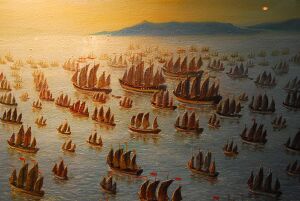Daxian Polynesian Wars: Difference between revisions
mNo edit summary Tag: 2017 source edit |
mNo edit summary Tag: 2017 source edit |
||
| Line 38: | Line 38: | ||
| campaignbox = | | campaignbox = | ||
}} | }} | ||
The '''Daxian Polynesian Wars''' (Daxian:潮汐之战) were a series of maritime conflicts centered on the [[Ocean of Cathay]] and the [[Polynesian Sea]] between various western colonial powers, local independent states and the [[Daxia|Qian dynasty]]. The main reason for the start of the conflict was the discovery and colonization of [[Peratra]] by the [[Daxia|Qian dynasty]] and its desire to forestall the expansion of other sea faring powers into the western Cathay area. The war soon transitioned into a Daxian effort to outright expel other powers from various possessions. Peace and trade normality would return to the area in 1728 with the signing of the Truce of Caserges. The [[Daxia|Qian dynasty]] had failed in the most important goal of its sea campaigns and the truce cemented the status quo antebellum; nonetheless the dynasty and its proxies remained dominant in the western end of the [[The Southern Route|southern route]]. | The '''Daxian Polynesian Wars''' (Daxian:潮汐之战) were a series of maritime conflicts centered on the [[Ocean of Cathay]] and the [[Polynesian Sea]] between various western colonial powers, local independent states and the [[Daxia|Qian dynasty]]. The main reason for the start of the conflict was the discovery and colonization of [[Peratra]] by the [[Daxia|Qian dynasty]] and its desire to forestall the expansion of other sea faring powers into the western Cathay area. The war soon transitioned into a Daxian effort to outright expel other powers from various possessions. Peace and trade normality would start to return to the area with the signing of several peace agreements with [[Kiravia]] and [[Burgundie]] in 1721 and in 1728 with the signing of the Truce of Caserges with the [[Caphiria|Imperium]]. The [[Daxia|Qian dynasty]] had failed in the most important goal of its sea campaigns and the truce cemented the status quo antebellum; nonetheless the dynasty and its proxies remained dominant in the western end of the [[The Southern Route|southern route]]. | ||
During the course of the conflict several independent polities were snuffed out by [[Daxia]] or had their populations supplanted by settlers from the mainland in behavior similar to western colonizers. The ultimate failure of the campaign would become the historical justification cited one hundred and fifty years later to commence building the [[Great Arsenal]]; a large and modernized war fleet to secure Daxia's dominion in the high seas. | During the course of the conflict several independent polities were snuffed out by [[Daxia]] or had their populations supplanted by settlers from the mainland in behavior similar to western colonizers. The ultimate failure of the campaign would become the historical justification cited one hundred and fifty years later to commence building the [[Great Arsenal]]; a large and modernized war fleet to secure Daxia's dominion in the high seas. | ||
Revision as of 03:09, 11 October 2023
| Daxian Polynesian Wars | |||||||
|---|---|---|---|---|---|---|---|
 A depiction of an imperial fleet on its way to the Siege of Dun-Kurrengev in Sarolasta | |||||||
| |||||||
| Belligerents | |||||||
|
|
| ||||||
The Daxian Polynesian Wars (Daxian:潮汐之战) were a series of maritime conflicts centered on the Ocean of Cathay and the Polynesian Sea between various western colonial powers, local independent states and the Qian dynasty. The main reason for the start of the conflict was the discovery and colonization of Peratra by the Qian dynasty and its desire to forestall the expansion of other sea faring powers into the western Cathay area. The war soon transitioned into a Daxian effort to outright expel other powers from various possessions. Peace and trade normality would start to return to the area with the signing of several peace agreements with Kiravia and Burgundie in 1721 and in 1728 with the signing of the Truce of Caserges with the Imperium. The Qian dynasty had failed in the most important goal of its sea campaigns and the truce cemented the status quo antebellum; nonetheless the dynasty and its proxies remained dominant in the western end of the southern route.
During the course of the conflict several independent polities were snuffed out by Daxia or had their populations supplanted by settlers from the mainland in behavior similar to western colonizers. The ultimate failure of the campaign would become the historical justification cited one hundred and fifty years later to commence building the Great Arsenal; a large and modernized war fleet to secure Daxia's dominion in the high seas.